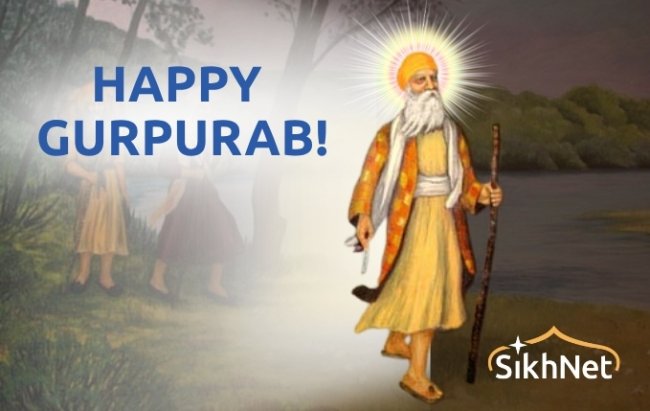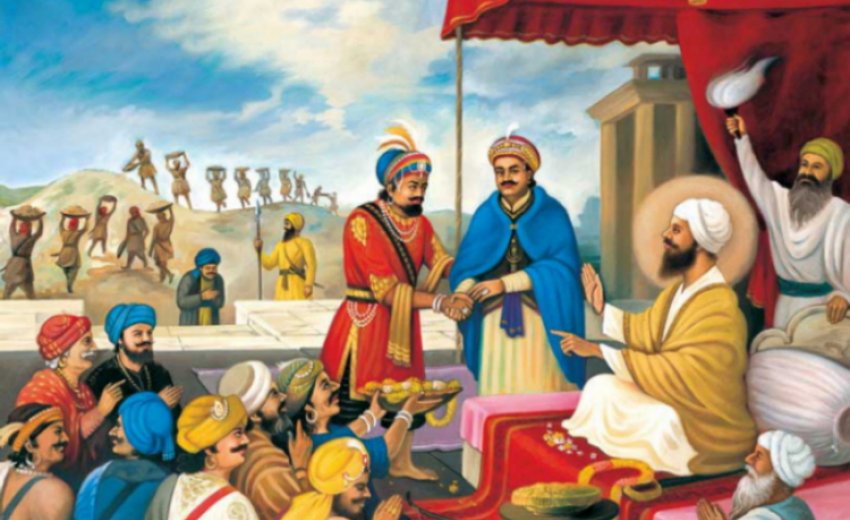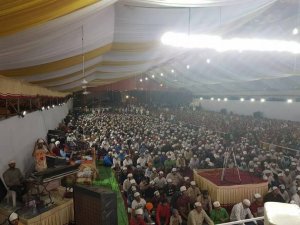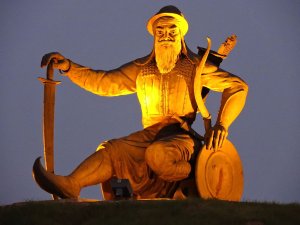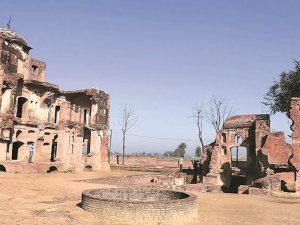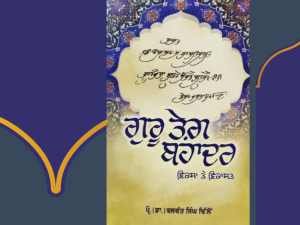The Rajput state of Jaipur in Rajasthan was founded in 11th century. For many centuries, the state was known as Amber till 1727 when a new capital Jaipur was built by then ruler Raja Sawai Jai Singh. The state borders Punjab and it was natural that there would have been interactions between the people of two states. The history of the Sikhs begins with the birth of Guru Nanak in 1469. There were other Rajput royal states in the region but for the purpose of this article, I will concentrate on Sikh relations with Rajput state of Jaipur only.
Guru Harkrishan & Raja Mirza Jai Singh
Dr Hari Ram Gupta in his History of the Sikhs Vol1 writes that the first contact between the Sikhs and Royals of Jaipur was when Mughal Emperor Aurangzeb summoned the eighth Sikh Guru, Harkrishan, to Delhi. He was escorted from Kirtarpur to the capital Delhi by men sent by Raja Mirza Jai Singh of Jaipur. The rule of Jaipur gave his personal assurance for Guru's security. On arrival at Delhi in January 1664, the Guru and his party were lodged in one of the Raja's palaces in Raisina, then a suburb of Delhi. This palace was later converted into a Gurdwara in 1783 and now known as Gurdwara Bangla Sahib.
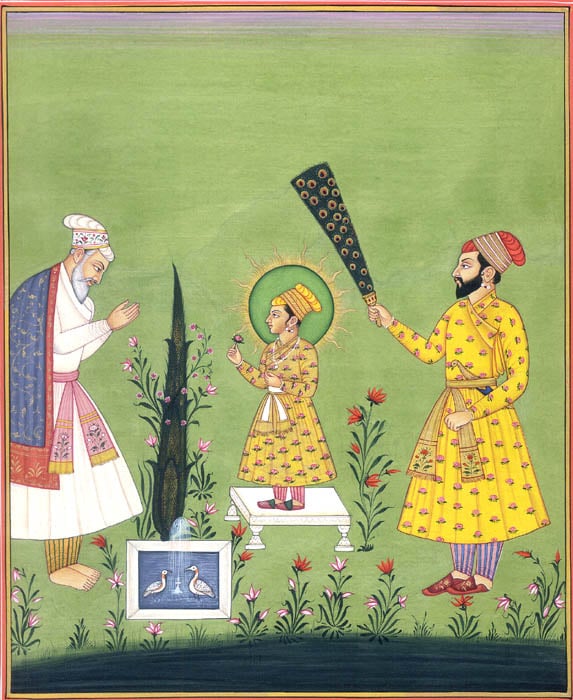
The people from all walks of life began to flock the palace to have a glimpse (Darshan) of Guru Harkrishan. Sikh chroniclers here mention an incident. Raja Mirza Jai Singh requested the Guru to identify the real queen out of the equally and well-dressed ladies surrounding him. The Guru went to a lady dressed as a maidservant and sat in her lap. This lady was the real queen. Perhaps the Raja wanted to test the Guru's intelligence (as he was only 7-8 years old), of which everyone spoke very highly.
At the time, an epidemic of cholera and smallpox broke out in Delhi. The young Guru began to attend the sufferers irrespective of cast and creed. He came to be known as 'Bala Peer' (child saint). During this period the Guru contracted small-pox and he passed away on 30th March 1664. He was cremated on the banks of river Yamuna where now stands Gurdwara Bala Sahib. The ruler of Jaipur (then Amber) and his descendants continued to be close to Sikh Gurus.
Guru Tegh Bahadur & Raja Ram Singh
Mughal Emperor Aurangzeb disliked Sikhs and found reasons to meddle in their affairs. Prior to Guru Harkrishan, he had summoned the seventh Guru, Har Rai but the later had sent his elder son Ram Rai to Delhi. This time he went ahead and issued an arrest warrant for Guru Tegh Bahadur, the successor to Guru Harkrishan.
Dr Gupta mentions that Guru Tegh Bahadur undertook a tour of Malwa (western Madhya Pradesh and parts of south-eastern Rajasthan) where sangat had been established by sixth Guru, Hargobind. He journeyed from village to village preaching his gospel. Aurangzeb could not tolerate Guru Tegh Bahadur's preaching. In the beginning of November 1665, the Guru was at village Dhamthan situated between Narwana and Tohana, 170 kms from Delhi. Alam Khan (Alo Khan according to Assamese work Padshah Buranji) Rohilla carrying warrants issued by Mughal Emperor came from Delhi.
On 8th November, 1665 he arrested the Guru Ji along with Bhai Mati Das, Bhai Sati Das, Gawal Das, Gurdas, Sangat, Jetha and Bhai Dyal Das both brothers, and several other Sikhs. They were brought to Delhi. The Guru was imprisoned (Nazarband) in the house of Prince Ram Singh, son of Raja Mirza Jai Singh of Jaipur. Aurangzeb issued the orders of Guru's execution. Ram Singh pleaded with the Emperor for mercy and to rescind his order. He undertook full responsibility for Guru's conduct and managed to secure his liberty on 11th January, 1666. In total the Guru remained in confinement for two months and three days.
The arrest in Guru Tegh Bahadur (and other Sikhs) and intervention of Prince Ram Singh is mentioned in two contemporary sources namely Bhat Vahi Jadobansian Khata Barthian and Assamese chronicler Padshah Buranji (also written as Badshad). Dr Fauja Singh in his book Guru Tegh Bahadur, Martyr & Teacher published in 1975 was the one of the early Sikh historians to quotes these sources.
Later Raja Ram Singh felt out of favour with Aurangzeb for allegedly assisting Shivaji Bonsle, Maratha chief to escape from Delhi. A year later the Mughal Emperor sent Prince Ram Singh to conquer Assam. Guru Teg Bahadur met him Gaya and together they went to Dakha in December 1666. The Guru stayed in this area and Assam till early 1670. During this period following the death of his father in 1667, Raja Ram Singh became the ruler of Jaipur.
Dr Ganda Singh in Maklziz-e-Twarikh-e-Sikhan, quotes a newsletter issued by Mughal Court that stated; "Tyag Mal, successor of Guru Nanak, stayed in Assam with the Raja Ram Singh." Tyag Mal was the previous name of the Guru. His father Guru Hargobind bestowed upon new name 'Tegh Bahadur' for latter's bravery in the battle against Mughals. Dabestan-e Mazaheb (or Schools of Religions), a contemporary Persian work mentions 4 defensive battles fought by Guru Hargobind against Mughals. The chapter on Sikhs is under the title Nanakpanthis has been translated by Dr Ganda Singh. Guru Tegh Bahadur was ultimately martyred in November 1675 by Aurangzeb.
Guru Gobind Singh & Raja Sawai Jai Singh
Dr Gupta records that Mughal Emperor Bahadur Shah, successor to Aurangzeb left Agra for the Deccan through Rajasthan on 2nd November 1707. He asked Guru Gobind Singh to accompany him. Bahadur Shah had facilitated the Guru and seems inclined to improve the relationship between Sikhs and Mughals. The Guru had two objects in view in accompanying the Emperor. One was to secure the royal order for punishment of Wazir Khan, Governor of Sirhind (for committing atrocities on people and his sons) and the second was to meet his old companion (Madho Das later Banda Singh Bahadur), who was then living at Nanded in modern Maharashtra.

Raja Sawai Jai Singh of Jaipur also accompanied them along with Raja Ajit Singh of Jodhpur and who joined the Emperor's camp on 15th February 1708. The Rajputs and Guru Gobind Singh lived together up to 20th April 1708, when the Rajputs left from the royal camp. A little later Guru Gobind Singh left the camp when he realised that the Mughal Emperor was not committed to punish Wazir Khan as indicated earlier.
The author of Tarikh-i-Bahadurshahi writes "Guru Gobind Singh one of the descendants of (Guru) Nanak had come into these districts to travel and accompanied the royal camp. He was in the habit of constantly addressing assemblies of worldly persons, religious fanatics and all sorts of people."
Guru Gobind Singh occasionally separated himself from the royal camp to preach his mission. We are not aware of the details on interaction between the Guru and Raja Sawai Jai Singh.
Mata Sundari
Guru Gobind Singh's widows, Mata Sundari and Mata Sahib Devi (spiritual wife and mother of Khalsa) were living in Delhi. Mata Sundari had adopted a boy whom she named after her deceased son Ajit Singh. Harbans Singh in Sikh Encyclopaedia mentions him as Ajit Singh Palit. He was given jagir by Bahadur Shah to counter Banda Singh Bahadur. He lived a life as a courtier and grew arrogant and haughty even towards Mata Sundari. Ajit Singh Palit and his followers allegedly mocked an assembly of Muslims at prayer. The Mughal Emperor ordered him to present himself at court with his hair shaven or face severe punishment. Ajit Singh cut off his hair and begged the Emperor's pardon. This deprived him of whatever respect he commanded among the Sikhs of Delhi. Mata Sundari along with his wife and son left Delhi and went to live at Mathura in the territory of Raja Sawai Jai Singh of Jaipur. The Raja provided them with a suitable residence and allowance. They stayed in Mathura for few years and then returned to Delhi.
Ajit Singh Palit did not change his ways and once, in his haughtiness, he caused a Muslim mendicant to be beaten to death by his followers in 1725. He was sentenced to death by torture by Mughal Emperor Muhammad Shah.
Banda Singh Bahadur & Raja Sawai Jai Singh
Banda Singh Bahadur won the province of Sirhind in May 1710. He opened communication channels with the Rajput chiefs of Jaipur and Jodhpur. According to a news that appeared in the Darbar-i-Akhbar-i-Mualla of 28th May 1710 "it was brought to the notice of the Emperor that Raja Jai Singh and Raja Ajit Singh had got the letters of Guru (Banda Singh Bahadur) and their replies had been dispatched to him". Though the contents of these letters are not known it is safe to assume that Banda Singh Bahadur was anxious to from a Sikh-Rajput alliance to overthrow the Mughal rule.
Emperor Bahadur Shah now led an expedition against Banda Singh and besieged Lohgarh (capital of Banda Singh) in December 1710. He ordered Rajput rulers to join him in suppressing the Sikh revolt. Raja Chhatrasal Bundela and Raja Udawant Singh Bundela, Pratap Singh, brother of Rana Amar Singh of Mewar and Raja Raj Bahadur of Kishangarh, arrived in the Mughal camp. Raja Sawai Jai Singh of Jaipur and Raja Ajit Singh of Jodhpur promised to follow suit but they loitered about Narnaul, and came to the Punjab 10 months after Mughal's campaign was over. They reached Lohgarh on October 1711. The ruler of Jaipur and Jodhpur were keeping their cards close to their chests.
The Akhbar-i-Darbar-i-Mualla of November 30, 1711 informs that "the rebel Guru (Banda Singh Bahadur) wrote to Raja Ajit Singh and Raja Jai Singh that they should come to his territory. They (the Sikhs) should be considered to have reached their territory. The Rajas killed the spies of the rebels and told that they were the servants of the Emperor. The rebels would be captured or killed soon." It further adds, "Muhammed Amin Khan wrote to Raja Ajit Singh and Raja Ajit Singh if they jointly marched against the rebel leader they could capture or kill him soon. The Rajas wrote in reply that the matter be reported to the Emperor. In case the Mughals were attacked by the rebels they (Rajas) would immediately reach there".
Banda Singh Bahadur, despite being claimed as Rajput, did not get assistance from any Rajput ruler from Rajasthan and Hill States of Punjab (now in Himachal Pradesh). In fact they along with Jaat chief of Bharatpur actively waged war against him from the Mughal side. The ruler of Jaipur and Jodhpur previous grievances had been resolved and they were made Subedars (Governors) of Mughal provinces. Hence they were happy to accept the suzerainty of the Mughals. Banda Singh Bahadur was captured along with 700 Sikhs. They were given the option either to choose Islam or die. All of them were executed.
Dr Balwant Singh Dhillon in his journal The Sikh-Rajput Relations, During the Eighteenth Century laments the lost opportunity. The Rajputs spurned Banda Singh Bahadur's proposal of Sikh-Rajput alliance which would have been a formidable challenge to the Mughal Empire at that time. If the proposed alliance had become a reality then the downfall of the Mughal Empire might have been hastened.
Sikhs in Rajput army under Raja Sawai Jai Singh
Dr Dhillon writes that according to Jaipur Tozi Sikhs records, in 1739 Sardar Gurbakhsh Singh, come into contact with the Jaipur state. Next year he was entrusted to employ 500 Sikh horsemen and 500 riflemen on behalf of the Jaipur state. Another Sikh leader Sardar Mir Singh, a jamiatdar along with his armed band was in Jaipur and was honoured with a siropao costing Rs.48.75 at that time. It is safe to say that Jaipur state in order to supplement its armed forces had no inhibition to enrol the armed Sikhs into its army.
Sardar Alha Singh & Raja Ishwari Singh
Dr Gupta quotes Tarikh e Ahmad Shahi that during the battle of Manupur near Sarhind between Mughal Emperor Muhammad Shah and Afghan ruler Ahmad Shah Abdali in March, 1748, Alha Singh of Patiala and Raja Ishwari Singh of Jaipur 'fought as comrades in arms' from the Mughal side against the Afghan invader. The battle resulted in defeat for Ahmed Shah Abdali, came to be known his first invasion of India. But the result did not deter him and he invaded North India 8 times till 1767.
Sikhs & Raja Swai Madho Singh
Dr Dhillon has studied contemporary Jaipur documents written in Rajasthani language & Devanagari script previously unknown to Sikh historians. He has studied kharitas (letters) and Tozi Sikhs (accounts under the name of Sikhs leaders). There are loose sheets on which accounts relating to different persons of different castes and religious denominations are recorded. These records have been further copied into a multi-volume document known as Dastoor Kaumvar.
There was a boundary dispute between the states of Jaipur and Bharatpur. In order to beat the Jaipur army, Raja Jawahar Singh, Jaat ruler of Bharatpur engaged a corps of 20000-25000 Sikhs who had come at that time to his country. A kharita written on 21st February 1768 by a Jaipur official informs that the Sikh army has crossed over Jamuna and the Jaat detachment holding its thana (security station). Another kharita written by Sampati Ram Bankawat informs that the fort of Kama and the area around it has come under the attack of a joint army of the Sikhs and the Jaats.
During this period Raja Swai Madho Singh, ruler of Jaipur died on 5th March 1768, and the throne passed on to his elder son, Prithvi Singh, a boy of five. A dispatch signed by all the Sikh leaders expressing grief and deep sorrow at the demise of the Raja was sent to Jaipur. Another document informs that on 13th March 1768, the Sikh leaders namely Sardar Sham Singh and Sardar Bakhat Singh were present at the investiture ceremony of new ruler (Raja Prithvi Singh) of Jaipur. A kharita written by Gangadhar on 25th April 1768 makes clear that Jaipur state had won over the Sikhs and had agreed to pay Rupees Two Lakh as Rakhi tax. Dr Dhillon states that a perusal of Jaipur records confirms that the arrangement formed in March 1768 remained in force for quite a long time.
Sikhs & Raja Sawai Partap Singh
Mahadji Scindhia was supreme in Delhi and there were frequent clashes between Scindhia and Jaipur. The later was forced to pay Chauth tax to Scindhia. The non-payment of the tax, along with political intrigues in the region led to tensions and military clashes. This may have prompted a formal alliance between Sikhs and Raja Sawai Partap Singh of Jaipur. A treaty with Sikhs was more preferred as Jaipur had a history of close relations and Sikh tax system of Rakhi (protection) was one-fifth was more lucrative compared to Maratha' tax Chauth which was one-fourth. All Sikh treaties were signed in the name of Sarbat Khalsa Ji during this period. Dr Dhillon writes that the following document in the form of a treaty was signed on 25th January 1787.
(Mark of sword in saffron colour)
Ahadnama (Agreement) between Sarbat Khalsa Ji and Maharaja Swai Partap Singh
"That there exists acknowledged friendship between Sarbat Khalsa Ji and Maharaja Dhiraj, Partap Singh Bahadur. It has been agreed upon by both the parties that the friends and foes of one party will be treated as friends and foes of the other. Sarbat Khalsa Ji will act according to the wishes of the Maharaja and the Maharaja will act according to the Sarbat Khalsa Ji. That any newly conquered territory in the zila of Bagar will be divided between both the parties after deducting the expenses of army. And the rakhi in the new territories shall be of Sarbat Khalsa Ji. There is no discord whatsoever between Khalsa Ji and Maharaja. And if the enemies of the Maharaja create disturbances, Sarbat Khalsa Ji shall join him. The holy Guru is a witness to this agreement and might sword is in between. Written on 5th Rabi-ul-Sani, 28th regnal year of Shah Alam."
The above treaty bears the seals of eight Sikh Sardars namely Baghel Singh, Dulcha Singh, Rai Singh, Raja Diwan Bahadur Singh, Nihal Singh, Gurdit Singh, Karam Singh Bahadur and Sada Singh.
 Sardar Baghel Singh & Raja Sawai Partap Singh
Dr Dhillon mentions an entry in Siyah Hazoor and Tozi Sikhs which is noteworthy to understand the above treaty. It states that on 3rd March 1788 Sardar Baghel Singh of Karorsinghia Misl, the most powerful Sikh chief in Cis-Sutlej region came and had a meeting with Shri Hazoor (Raja Swai Partap Singh) who was camping in village Ladhuwas of pargana Riwari. They shook hands and thereafter sat very closely on the same carpet. For one hour they held discussions on important matters. After that, the Jaipur ruler sends him off and presented to him four bundles containing costly gifts including a sarpech and a kalghi (plume). On 31st July 1788, the Sikh leaders proposed a similar treaty to Maharaja Bijay Singh of Jodhpur.
Sardar Baghel Singh & Raja Sawai Partap Singh
Dr Dhillon mentions an entry in Siyah Hazoor and Tozi Sikhs which is noteworthy to understand the above treaty. It states that on 3rd March 1788 Sardar Baghel Singh of Karorsinghia Misl, the most powerful Sikh chief in Cis-Sutlej region came and had a meeting with Shri Hazoor (Raja Swai Partap Singh) who was camping in village Ladhuwas of pargana Riwari. They shook hands and thereafter sat very closely on the same carpet. For one hour they held discussions on important matters. After that, the Jaipur ruler sends him off and presented to him four bundles containing costly gifts including a sarpech and a kalghi (plume). On 31st July 1788, the Sikh leaders proposed a similar treaty to Maharaja Bijay Singh of Jodhpur.
Conclusion
The Sikhs and Rajput state of Jaipur had a close and mostly cordial relation for about 150 years. The daughter of royal family of state of Nahan (now in Himachal Pradesh) is married to Jaipur royal family. Guru Gobind Singh stayed at Ponta Sahib for couple of years in the territory of ruler of Nahan. They definitely have some artefacts gifted by the Guru. I wonder if the royal family of Jaipur have any relics relating to Sikh Gurus.
In 1805 following the defeat of Daulat Rao Scindhia, Delhi and surrounding region passed on to British East India Company. Jaipur became a British protectorate state. Few years later in 1809, the Cis-Sutlej Sikh states went under British protection fearing annexation from Maharaja Ranjit Singh who was supreme in Trans-Sutlej Punjab. This ended the formal and fascinating association of Sikhs and Rajput State of Jaipur.
